Limelight
In a universe of more than 1200 collaborators, there are many months when there is more than one collaborator with a performance suitable for “Limelight”. An example of this is the fact that for several months we receive more than one nominee. This led to a change in the publication policy: BIP has started to highlight all nominees, without considering the merit (because all nominees have much merit!). Additionally, considering the criteria for news opportunity, an interview with one of the nominees is developed.
THIS MONTH WE SPOKE WITH Pedro Regadas (SCOM)
1. How did the opportunity of working at INESC TEC emerged?
The opportunity came through the designer Susana Fernando who collaborated with INESC TEC for some time. As we both have a design studio in the same place where we share work experiences, in one of these sharing moments, the opportunity to collaborate with INESC TEC emerged.
Since INESC TEC is a reference as a Research Centre of excellence, it was important for the communication service to also contribute to this excellence, following the example of other institutions in Europe and USA with the same mission. In that regard, to make that happen, it was important that INESC TEC would have the communication design incorporated in its strategy and to have planned two fundamental issues. First, to clarify its corporative identity and its market position and second,lot to slowly introduce communication design concepts inside the philosophy and work culture of the institution.
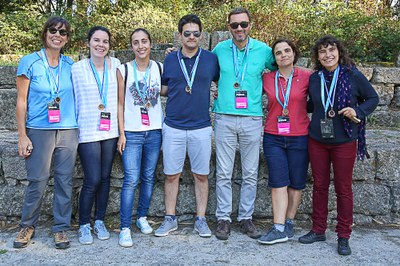
2. In what way does the Design field fit in an institution like INESC TEC?
Design is an important subject in any institution, organisation or company and is nowadays considered a key factor for the business success. However, there is a lot of confusion in the definition of its scope and functions, resulting in a difficult integration of the design, causing a deficit of it in the organisations. This deficit of Design has direct consequences both at the institutional communication level and the competitiveness level of the developed products/projects. If, in one hand, the organisations still have a distorted view of what Design is, and mostly about the expertise of a Designer, on the other hand, it is up to these professionals to demonstrate their skills towards rapprochement. In that regard, it was essential to integrate the expertise of communication design in the structure. An institution with the current dimension of INESC TEC needs Design to be framed not from the point of view of the specific resolution of a certain problem, but in a systemic vision introducing, step by step, the concepts of communication design that must act in an integrated way. Any isolated intervention results in a divergence and contradiction of images and the contribute of Design in this process is crucial and important. And for this, the role of the Designer is crucial because he is one of the major mediators, interpreters and managers of information within an organisation. By performing its activity, the Designer contributes with aesthetic, technical, educational, scientific, marketing, administrative and organisational expertise to the development of products/services.
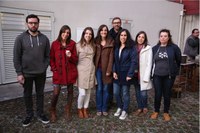
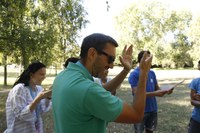
3. What are the challenges of working at the Communication Service?
The challenges come in different levels, ranging from the institutional communication to the design and development of visual identities of R&D projects and their application. Concerning the institutional communication, the biggest challenge is the creation of a design culture with the purpose of promoting the image and the prestige of the institution both internally and externally. Creating this design culture within the institution demands more than just developing a logotype, it's necessary to develop a programme of a coordinated image - that represents the culture and the values of the institution. And for this, it is necessary to create and to align a set of tools and a unique universe of INESC TEC brand, which should easy to be reproduced and fast to be identified as belonging to the institution. It entails to improve the typographic system, to develop the chromatic system and to add an iconographic and infographic system that is transparent to the institute and to its fields of action — Research (Clusters) and Innovation (Tec4), which had no identity until then; and to manage the behaviour and the organisation of these systems. For that, it’s necessary to define the standardisation principles of the image of the institute, aiming to motivate the feeling of belonging by the collaborators, to make the identification processes easier by the public and to provide a focus, thus promoting the general communication. With this, it is intended to consolidate the coherence, the personality, the positioning and the self-knowledge of INESC TEC about itself.
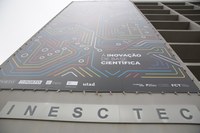

4. This nomination comes from the FCT’s evaluation. How was it to carry out this work?
It was complex to carry out this work because of the involvement of the 13 R&D Centres, but it was also exciting because of the challenge that it represents for the institution. It was important, in this moment of the institution's life cycle, which takes place every four years, to be able to rise to the challenge.
We had the last year’s experience during the visit of SAB (Scientific Advisor Board), and for that reason, we prepared ourselves for what could happen.
In order to meet the goals of the application, it was necessary to create a working process that could effectively address the problems that arose throughout the work. Anticipating the problems and creating solutions for them was undoubtedly the biggest challenge, because in order to solve problems, it’s necessary to know them well so that the solutions found can solve problems in a better way compared to how they were previously solved. For that, one must avoid the trap of seeing Design only by the perspective of the visual result. Design is an activity oriented to the resolution of problems, creation, coordinating and systematic activities and works closely with the management activity. To create must mean to solve problems in a better way than they were before.
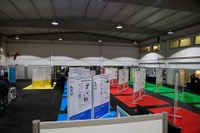
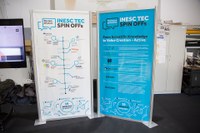
5. We will end this interview by asking you to comment on your nomination by INESC TEC’s Board:
«I nominate Pedro Regadas for Limelight of October for his exemplary commitment and pride with which he imagined, designed and delivered all the graphic material supporting the FCT’s evaluation visit.»
It was with great gratitude and surprise that I received the nomination from the Board and I am very pleased to know that my work is recognised. However, I would like to highlight that this recognition also goes to the different colleagues who I worked with, whom I share this distinction with.
LIMELIGHT - October
- José Pedro Pinto, CTM

“During the month of October, José Pedro demonstrated an exceptional performance and had a key role in the team of the European project FotoInMotion, having contributed to consolidate the image of professionalism and the technical and scientific ability of INESC TEC among the consortium. The work that he developed allowed to not fulfil goals but also to anticipate the launch of the first tool of INESC TEC’s full responsibility that is vital to ensure the pursuit of the planned works. He also took a set of operational responsibilities, showing autonomy and coordination capacities with the entire team. The excellence of the results was largely recognised by the partners of the project. The coordination of CTM would also like to highlight the commitment and quality of work from the entire team of junior researchers of the FotoInMotion project, for the team spirit and the mutual help that have definitely contributed to the success of José Pedro’s work.” Coordination CTM
- Pedro Regadas, SCOM

“I nominate Pedro Regadas for Limelight of October for his exemplary commitment and pride with which he imagined, designed and delivered all the graphic material supporting the FCT’s evaluation visit.” Board
- Teresa Araújo and Guilherme Aresta, C-BER


“This month, C-BER would like to nominate for Limelight the two researchers Teresa Finisterra Araújo and Guilherme Aresta for their excellent and essential collaboration in the elaboration of an European project proposal, for their high level of developed research, for the organisation of Challenge BACH that attracted an excellent international participation, for their recent publications that were accepted, published and submitted and by the high number of quotes in an article that was published about a year ago (it has more than 70 quotes in Google Scholar).”, Coordination C-BER


